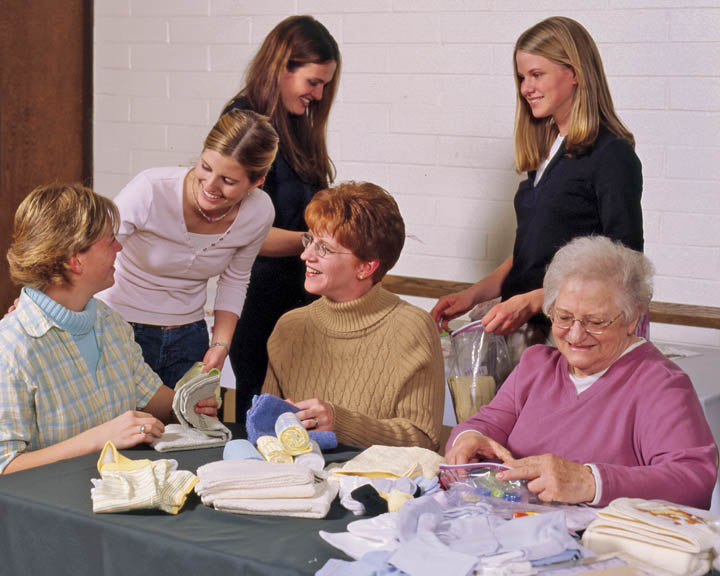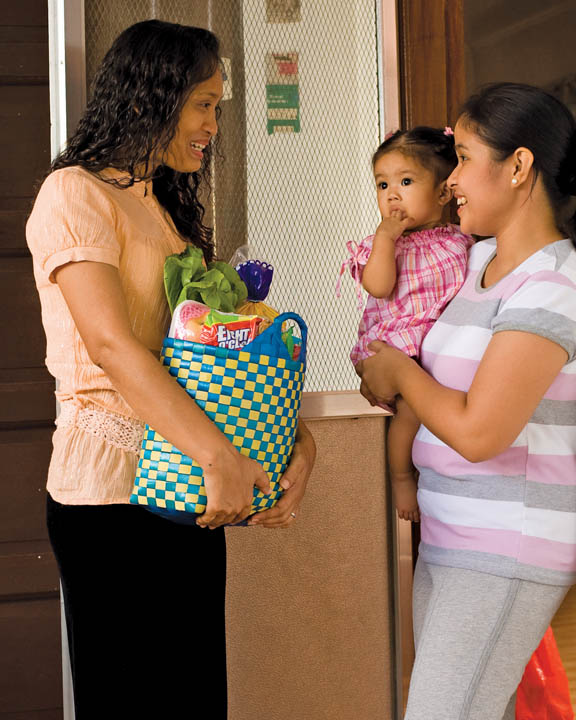Difference between revisions of "Mormon Women's Organization"
(Created page with "250px|thumb|alt=Relief Society|left|Mormon Women work on a Humanitarian Aid Project The '''Relief Society, or the women’s organization''' of [[The...") |
(No difference)
|
Revision as of 00:21, 11 November 2011
The Relief Society, or the women’s organization of The Church of Jesus Christ of Latter-day Saints, is one of the oldest and largest women’s organizations in the world.[1] It was founded in 1847 under the leadership of Joseph Smith, then prophet of The Church of Jesus Christ of Latter-day Saints. It is a world-wide organization that has over 6 million members in over 170 countries and territories.
The motto of Relief Society is “Charity never faileth.” It is a Christ-centered organization of a Christ-centered church. Julie B. Beck, 15th Relief Society general president said, “Through Relief Society we practice being disciples of Christ. We learn what he would have us learn, we do what he would have us do, and we become what He would have us become.”[2] As a Christian women’s group, it focuses on both the individual woman and those in need of charity or acts of service. Women are encouraged to study and learn in their own discipleship, and simultaneously turn their focus outward to the needy, the sick, the lonely, or the widowed.
The purposes of Relief Society are: Increase faith and personal righteousness, strengthen families and homes, seek out and help those in need.[3]
One of the programs of Relief Society that allows the sisterhood of saints across nations to fulfill these purposes is visiting teaching. Women in Relief Society are asked to visit a few women in their congregation, or ward, each month, to befriend them, share Christ-centered messages with them, and to give assistance where help is needed.
Henry B. Eyring, a counselor in the First Presidency, testified that visiting teaching is part of the Lord’s plan to provide help for people all over the world:
- “The only system which could provide succor and comfort across a church so large in a world so varied would be through individual servants near the people in need. The Lord had seen that coming from the beginning of Relief Society. He set a pattern in place. Two Relief Society sisters accept their assignment to visit another as a call from the Lord. That was true from the start. The members of Relief Society have always been trusted by local priesthood shepherds. Every bishop and every branch president has a Relief Society president to depend upon. She has visiting teachers, who know the trials and the needs of every sister. She can, through them, know the hearts of individuals and families. She can meet and help the bishop in his call to nurture individuals and families.”[4]
Visiting teaching empowers women to care for one another and for those in need. Women have the freedom to carry out their visiting teaching assignments in the way that they see fit, and in the way that best suits the women they have been asked to visit teach. Caring for all of the women in the Church, and by extension, their families, is a significant responsibility. This responsibility has been entrusted to the women of the Church since Relief Society was first organized. In 1947, Belle S. Spafford, 9th general president of the Relief Society said, “Ours is a healing mission requiring the larger heart, the kindlier touch, the steadier will.”
In carrying out visiting teaching responsibilities, women in the church are essentially performing as a collective group the responsibilities that would be carried out by individual pastors or congregational leaders in other faiths. Collectively, visiting teachers are encouraged and instructed to regularly visit each other in the hopes that they can discover needs, spiritual or temporal, within the group, meet those needs, and collaborate with other women and leadership within the congregation in caring for the women and their families.
Each congregation’s unit of the Relief Society is presided over by a president who also sits on the congregation’s governing body, the Ward Council. In the Ward Council, she reports on visiting teaching and other activities within the women’s group. It is expected that she lead the conversation on how to best meet the spiritual and often temporal needs of the women within her group and of their families, coordinate the combined efforts of other groups within the congregation in meeting those needs, and report back when those efforts have been completed.
The Relief Society president is asked to give her volunteer service for a few years. The congregation’s leader, the bishop, prays for guidance in making assignments throughout the congregation, or ward. As part of this process, he asks a woman in the ward to serve as the Relief Society president. She then works with the bishop to select two counselors and a secretary to form a presidency. There is no set term of service. Individuals serving in any capacity within the congregation can expect to serve for a period of months or years.
The presidency works together to invite other members of the group to fulfill assignments and serve in offices or callings to support the presidency in carrying out the broader mission of the Relief Society on the local level. Women can be called to specialize in supervising and assisting the sisters in their visiting teaching efforts, to provide doctrinal instruction during Sunday meetings, to coordinate and oversee charitable service in and out of the congregation, and to plan and carry out uplifting activities.
The Relief Society exists to help women of The Church of Jesus Christ of Latter-day Saints to better themselves, and to better the lives of the women they are asked to visit, as well as their families. It is a unique and Christ-centered women’s organization.

